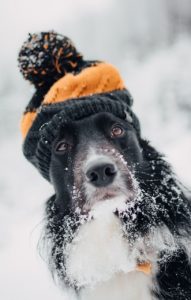As cold weather sets in, here are some tips to prepare and ensure your pets are warm and happy throughout winter.
Take Caution When Outdoors
When temperatures reach levels of extreme cold, limit outdoor walks and monitor your pet’s behavior for signs of stress or discomfort. Letting your dog outside to use the bathroom or go for a quick walk is OK, but never leave a pet outside for a long period of time, especially during a winter storm.
Don’t let your dog off its leash after snowfall, as snow can mask familiar scents. This can cause your pet to become disoriented or lost if they get too far away.
Add Extra Layers
Despite efforts to limit time outdoors, your pet needs to go outside for bathroom breaks and exercise. Pets who are small, short-haired, old or have any health issues or illnesses may be more sensitive to cold weather.
Pet sweaters can help keep your pet warm. If your pet is shivering, that’s a sign they need extra layers. To help trap body heat and protect paws from extreme cold, consider using booties when venturing outside.
Watch out for Hazardous Chemicals
Many people use snow-melting products like deicers, antifreeze and salt, which can cause skin irritation and be fatal if ingested by your pet. Pet parents should keep an eye on their pets when they’re outside and be mindful of hazards. After a walk, it’s important to thoroughly rinse your pet’s paws and stomach, especially after walking in areas where these products are frequently used.
Keep Skin Protected
Just like humans, many pets get dry skin during the winter. When your pet needs a bath, try using a pet-friendly moisturizing shampoo to help keep skin healthy and hydrated. If your pet’s skin seems extra dry, supplements like fish oil can be added to your pets’ food to help the skin and coat. It’s important to keep an eye on skin health and check with your vet if issues persist as they could be signs of larger problems.
Have an Emergency Plan
While creating emergency kits in case of a storm or power outage, don’t forget about your pet’s needs. A pet’s kit should include supplies needed to keep them fed, warm and secure during emergency conditions like blizzards or extreme cold. Items like sweaters, insulated vests, paw booties, pet-safe ice melt and a heated bed or pad can help avoid risks associated with freezing temperatures.
Gather any other care items your pet may require such as medications, puppy pads, waste bags, litter box supplies and calming spray. Store a one-week supply of food in a waterproof container along with bottled water and portable bowls as well as a list of feeding routines and behavioral considerations in case others need to care for your pet.
Ensure Identification Information is Current
While winter emergencies may add to the importance, it’s crucial your pet wears a tag displaying your phone number year-round. Microchip and register your pet with current contact information and tuck a copy of their vaccination and medical records, veterinary contact information and a current photo in your emergency kit.






